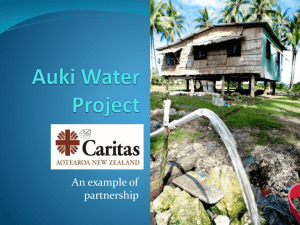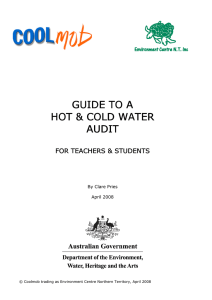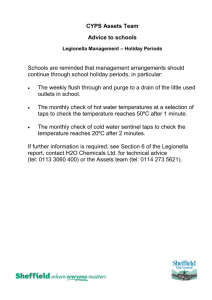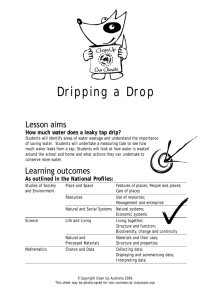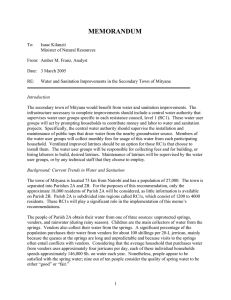water supply
advertisement
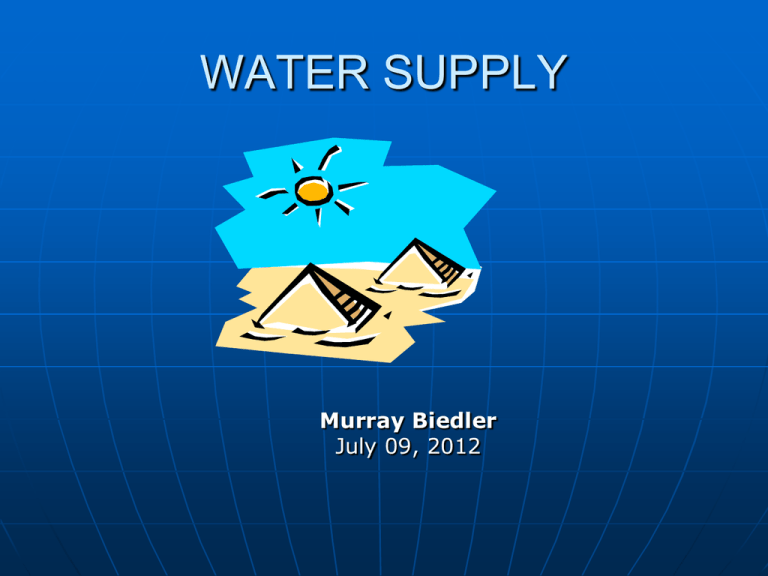
WATER SUPPLY Murray Biedler July 09, 2012 WATER NEEDS Drinking Food Prep Hygiene / Washing Agric / Stock CHARACTERISTICS of WATER SUPPLY Quantity Quality Access and Sources Treatment Not static… constantly changing WATER QUANTITY Europe 150-litres/p/day average Emergencies • • • • 20-litres/p/day minimum 5-litres/p/day: opening of emergency Health centre: 1-2 litres/consultation Hospital: 40-60 litres/patient/day (100 for surgery) • Therapeutic feeding centre: 30 litres / child / day • Cattle: 30 l/animal/day • Small animals: 5 l/animal/day WATER QUALITY Bacteriological quality linked to: • Faecal contamination indicative of pathogens (e.g. cholera or typhoid) (rapid assessment in field) Chemical quality linked to: • Geological surroundings, agricultural or other industrial/commercial activities (rapid assessment difficult lab required) WATER QUALITY Good Quality: Contains no pathogens Low concentration of toxic products Clear (low turbidity) Is not too salty or mineralized Colour, odour and taste acceptable WATER ACCESS: CHALLENGES Time Cost Distance & Security WATER ACESS: SOURCES Surface water • rivers, lakes, ponds (access seasonal) Ground water • Difficult access but can be better quality Precipitation • Seasonal: rain, snow, fog capture WATER ACCESS: SURFACE On site pumps to storage / tower Gravity network, pipes & taps WATER ACCESS: GROUNDWATER Hand-dug wells: hand pumps, buckets Boreholes (shallow & deep) pumps: hand, motor, solar, wind… WATER ACCESS: SPRINGS Springs: on site pumps or gravity into networks, pipes & taps WATER ACCESS: PRECIPITATION Rainwater collection gravity to tanks networks, pipes & taps WATER ACCESS: STORAGE Storage provides availability on regular basis Storage tanks provide: • Treatment of large volumes • Pressure with gravity Dams: surface and subsurface; seasonal & precipitation constraints WATER ACCESS DISTRIBUTION 1 tap/200 persons for displaced populations Health facilities: taps for staff, patients & visitors Container distribution WATER TREATMENT Chlorination simplest & most efficient way to kill micro-organisms Residual chlorine necessary to attack further contaminations Chlorination becomes inefficient if the water is too dirty or turbid SEDIMENTATION & FILTRATION Water stored until suspended particles settle Water can be filtered with sand or other designed materials Coagulation-flocculation for heavy turbidity using chemicals (e.g.ferric chloride or aluminium sulphate) DOMESTIC STORAGE Container lid or top (e.g: jerry can) or a narrow opening (transport) kept clean regularly dosed for residual chlorine (storage) MAIN ISSUES TO BE CONSIDERED NEEDS ANALYSIS TECHNICAL OPTIONS ENSURING QUALITY ADAPTED WATER SUPPLY AVAILABLE QUANTITY SANITATION AND HYGIENE POTENTIAL SOURCES
